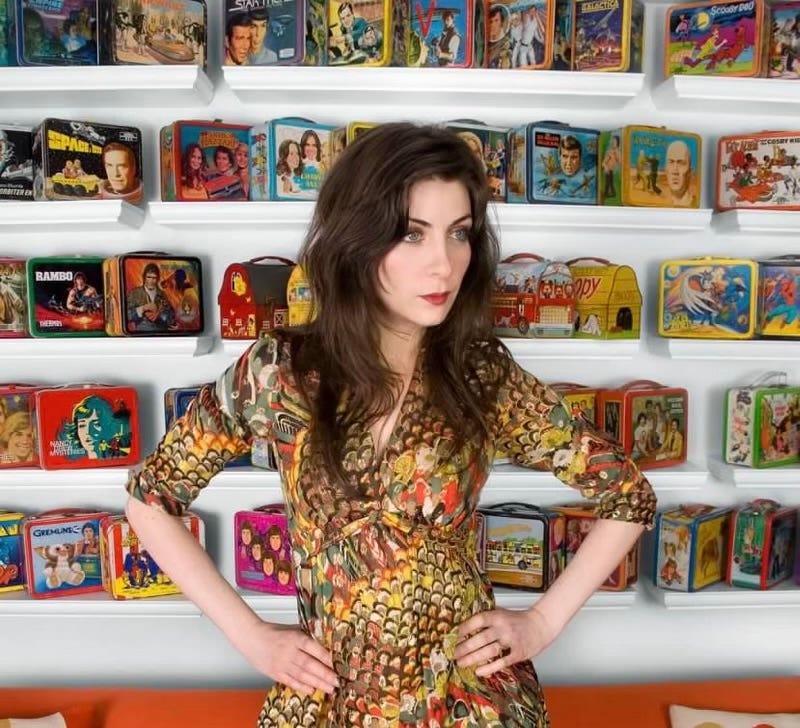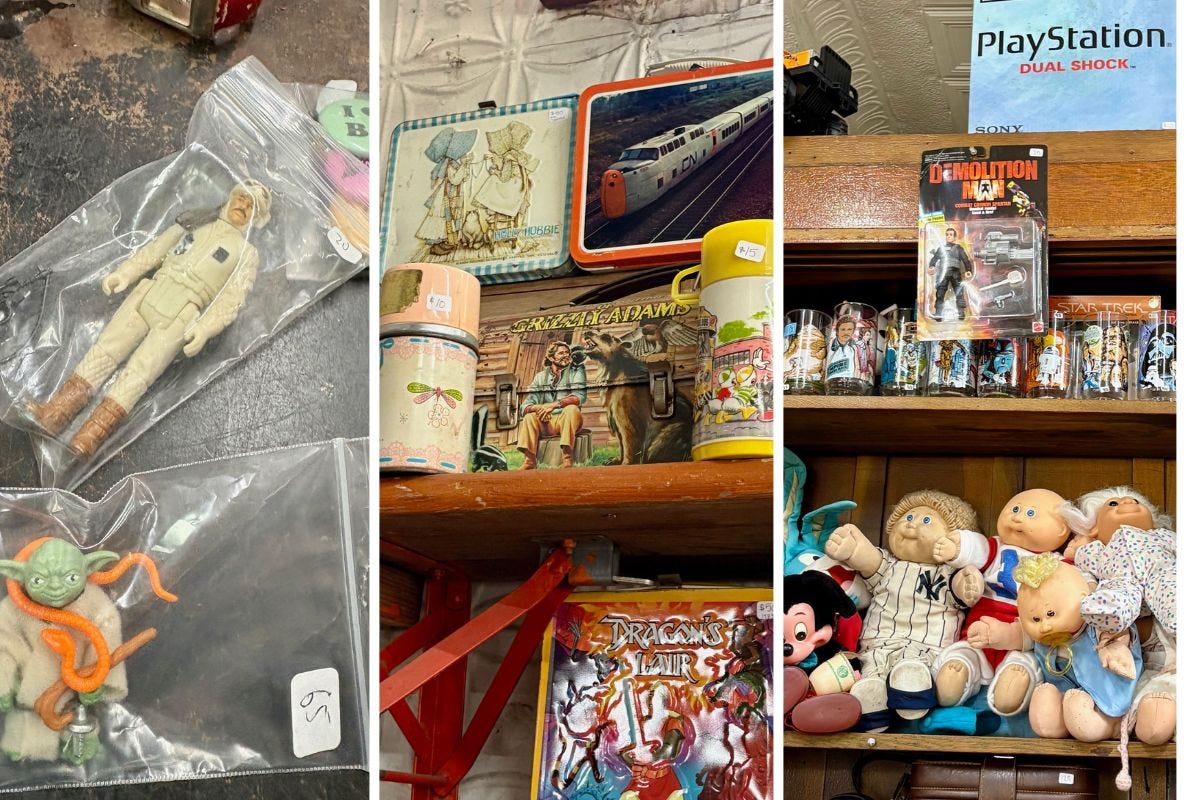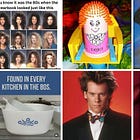Hi WNVM-ers,
Cheryl here. First of all, a huge welcome to all the new subscribers who have found us over the last few weeks! And THANK YOU to all of you who have been faithfully reading, liking, and commenting every week since Fawnia and I started this project. We appreciate you all so much.
It feels like the right time to re-introduce ourselves and re-commit to what we do: We write about things we think Gen X-ers will find interesting, like celebs of our era/generation doing stuff (good, zeitgeisty, and otherwise), how the ‘80s and ‘90s are relevant now, and my personal favorite topic, how our nostalgia gets monetized. That’s what today’s story is about.
I talked to two fun Gen X-ers who are on different sides of the vintage goods economy: a collector who is divesting some of her treasures and a vintage store owner who is taking it off her hands. The end result is a nostalgic look back at the toys and collectibles from the ‘80s and ‘90s and the surprising ways (I mean, Grimace?!) current pop culture affects their worth and desirability.
Plus, Keanu Reeves is finally back in the news, Demi Moore had a spectacular red carpet fashion run, and is “boom boom” ‘80s fashion a thing?
You may need to read this post in your browser so it doesn’t cut off.
I Will Collect You and Capture You
Buying and selling our memories.
By Cheryl

The most ubiquitous merchandise you’ll find at traditional flea markets includes primitive wooden objects, old bottles, and so many lithographs of old-timey wildlife illustrations. But Dan Treiber is more interested in whatever is in the forgotten box behind the charming milk glass vases.
“Generally, somebody who sells cheese boxes and shoe lasts and clothes pins has a shitty box of toys,” says Treiber, 45. “I always bought the shitty box of toys.”
As Treiber has learned, one person’s shitty toy is another’s much-loved, late-’70s era Lynda Carter Wonder Woman doll with a painted-on bustier that she got rid of after college and would like to maybe own again. (Fine, I think about that doll too much.)
For the last 15 years, Treiber and his wife Reina Mia Brill have made a living selling decades-old cast-off toys and childhood ephemera, much of it from the ‘70s, ‘80s, and ‘90s. The shop, Dan’s Parents House, is in a circa-1860s building on City Island, a tiny, three-block wide spit of land in the Bronx that feels like it’s from a bygone era itself. The shop is packed to the rafters with toys, pins, figures, records, and various oddities, like a box of Weepuls, a thing you have definitely seen but will not know was called a Weepul.
I visited the store to see how our childhoods were being monetized, to chat about the cyclical nature of nostalgia, to get a glimpse into a world where people know how much a Holly Hobbie lunchbox should cost, and to learn how modern pop culture and technology have changed the equation on it all.
Which Lunchbox Did You Have?
Marissa Gimeno, who I first met about a decade ago when I profiled her for her very cool day job doing still life makeup art, owned about 100 metal lunchboxes. She never carried her lunch in one when she was a little kid, but started buying them in the ‘90s.
“There was a ‘90s rave aesthetic, where kids would carry lunch boxes as their purses,” she says. “That was definitely very much part of my world.”
Gimeno bought lunchboxes because she loved the art on them, especially the ones with plaid and floral designs made by the Ohio Art Company, which is most famous for the Etch-a-Sketch. She displays the boxes on a shelf in her home as an art installation. She also collects Pez dispensers, but recently decided it was time to get rid of some of her stuff.
(If this makes you want to learn more about lunchboxes and the people who made them, I highly recommend this podcast Gimeno told me about. It’s fascinating.)
‘I’m Over Objects’
The office displaying the lunchboxes became Gimeno’s daughter’s bedroom. (Her tween is not super happy about the unwanted decor.) She had another 50 lunchboxes stored away in boxes and hadn’t missed them, so thought it might be time to “bless and release them.”
Gimeno had concerns about burdening her daughter later. She’d watched family members downsize for moves to retirement homes and others deal with the emotional and labor-intensive job of getting rid of a lifetime of belongings after their loved ones died.
It reminds me of a NYT article that I think about a lot, detailing how the kids of baby boomers don’t want their parents’ china and knick knacks. Maybe lunchboxes, vintage band t-shirts, and Star Wars figures are the Gen X equivalent.
“Half of [the fun] was the actual hunt. It was the searching. Yes, it's the object too,” Gimeno says. “But it was the fun of driving to weird places or exploring back roads or going to garage sales on the weekends. It was a high, you know? Now, I’m kind of over objects.”
Off she went to Dan’s Parents House with the lunchboxes.
Raid The Attic
To snag a spot at the famous Brooklyn Flea 15 years ago, Treiber hit up his parents’ attic, where she had old cameras and toys, including — somehow — unopened Star Wars figures from 1982. He spent years on the road scouring flea markets in Ohio and Pennsylvania to buy things.
Dan’s Parents House was a popular fixture at the Flea and holiday markets in NYC. He earned enough money flipping nostalgia to purchase the house where he grew up on City Island and the building that houses his store.
The shop makes about 30% of its income from vinyl sales (Treiber used to own an indie record label). But he says the majority of money comes from the “high shelves,” where the expensive stuff is, and the “low shelves,” which are cheap and move a lot of volume. That means selling tons of loose figurines that cost three for $20 and then hopefully a Star Wars AT-AT Walker with the original box. The box alone is $300, but Treiber would sell you both for $450.

Lunchboxes aren’t the most popular collectible at the moment, but Treiber is confident they will all eventually sell, and they’re an “aesthetic” he likes having in the store. They’re priced from $30 (for the exact Holly Hobbie one I had, OMG) to $95 (for Thundercats), depending on the condition and presence of a thermos.
Here’s what he thinks about other popular childhood toys:
Cabbage Patch Kids: “They do not fly off the shelves, but do go away eventually. Obviously if the outfits are good [and] hair is clean, they move much quicker.” (They usually go for $20 to $50.)
Beanie Babies: “Beanie Babies are honestly like a disease you can’t get rid of. Every single person who ever has items to sell me has a box of them. They are worthless as a collectible because there are millions of them. They are, however, cute objects and will sell for $3 each forever.”
Garbage Pail Kids: “Garbage Pail Kids are through the roof. Series 1 from 1985 complete sets (82 cards) regularly sell for $500-$1500 depending on condition.” (Possibly delusional eBay sellers have them listed for $35K to $60K.)
Matchbox/Hot Wheels cars: “This is what I sell the most of: loose and beat to shit.”
The Grimace Effect
Sometimes things in the shop sit around until the zeitgeist gets a hold of them — like Grimace, that purple, furry blob of a McDonald’s mascot who was introduced in 1971. Treiber has always moved a ton of those possibly toxic character glasses fast food restaurants used to sell, but Grimace was never terribly popular. Until he suddenly was.
Like many inexplicable things on the internet, Grimace went viral in 2023. Then in 2024, he threw out the first pitch at a Mets game, and the team proceeded to win a bunch of games. Grimace was credited; he even has his own purple seat at the team’s stadium. Treiber sold the 35 Grimace glasses he had almost instantly.
Treiber saw this effect when the Barbie movie came out in 2023, too. While older Barbies have always been valuable, he says ‘80s versions are less so, because so many were produced. They weren’t fast movers until the Barbie blitz happened.
“I sold every single Barbie in a box that I could get,” he says. They doubled in price from $20 to $40, but the demand has since died down.
It will be interesting to see if the forthcoming 2026 Masters of the Universe movie has the same effect. Treiber says original ‘80s He-Man toys had had a robust secondary market. But he thinks the franchise “ruined itself” when Mattel, also Barbie’s manufacturer, reissued a bunch of toys that looked like the originals. If the Barbie marketing is any indication, one can assume it will flood the market again when the movie launches and the prices of the early ones will skyrocket.
Preserved In Amber…or Lucite
Shows like “Pawn Stars” and “American Pickers” have become the thrifting equivalent of what house flipping shows did for real estate. Everyone is trying to game the system. Shoppers have eBay, Etsy, and various pricing apps at their fingertips to give them a sense of what things are worth. Treiber sees customers in his shop scanning barcodes, which annoys him.
But nothing is more infuriating for Treiber than the grading system. “I find it vile,” Treiber says.
There are companies that will grade video games and collector cards. This means enclosing them in lucite, never to be played again, and stamping on a number denoting its condition.
“Nintendo games were $1 a piece for like 20 years, and now they're very expensive and getting more and more valuable,” he says. “The problem is people want them, but they're not playing them. They want them as objects.”
Yoda No Longer The Future, He Is
Today’s shelf of rusting lunchboxes is likely destined to become a row of dented Stanley cups by the time Gen Z hits their 40s.
Like every trend cycle, the demand for Gen X toys is starting to fade. There’s a circle of life here that Treiber is seeing happen in real time. He saw it with baby boomer-era toys. Roy Rogers is out. Trains are out. When I told him my dad was a train guy, he said, “Everyone's dad was a train guy. But there aren't any new train guys.”
While Star Wars is still “blue chip,” more people come into his shop these days looking for Teenage Mutant Ninja Turtles than stuff from a galaxy far, far away. Treiber predicts that Toy Story gear will be hot eventually. He is pretty pragmatic about it all, but still has some feelings about the changing of the guard.
“Now people ask me for Power Rangers. I don't touch Power Rangers,” he says jokingly. “How dare you!”
We are two Gen X journalists who celebrate people of our generation doing cool things, as well as analyze all the '80s and '90s nostalgia in current pop culture, fashion, and beauty. Read more stories like this one here!
You Oughta Know
Kea-News! After a dearth of Keanu, we've been inundated with quotes from him, thanks to a new docu-series he’s released on Roku called “Visionaries" and a press blitz in which he has somewhat controversial facial hair:
"We have been on a couple of trips together on the motorcycle and we have enjoyed it." (On girlfriend Alexandra Grant) [E News]
"I want to go to Mars." (We are OK with this if he takes El*n with him and leaves him there)
"Do I have more…? More zest? Yes." (Context not important.) -CW [ET YouTube]
When one celebrity lifestyle brand dies (Cheryl Hines), another inevitably pops up in its place (Liv Tyler). -CW [Puck].
My enlightened woke king and girl dad Don Johnson — omg he is the fatherly, climate warrior captain in “Doctor Odyssey" — loves working with Ryan Murphy. Executive Producer of “Miami Vice,” Michael Mann, though? -FSH [WTF With Marc Maron]
A Lollapalooza oral history book comes out 3/25 and it looks juicy. “Billy Corgan was such a raging asshole…” (I told you. Punchable.) -CW, who attended the first Lolla [Stereogum]
Bye, quiet luxury and hello to the ‘80s-esque “boom boom” aesthetic — as coined by Substack’s 8Ball — which sounds kinda like that coked-up, big shoulder pad-filled party at the beginning of Less Than Zero. -FSH [The Cut]
Netflix’s “Fear Street” franchise heads to prom circa-1988, with a clear Carrie reference, period-incorrect hair, and a pretty deep-cut nod to the cover of Lois Duncan’s 1981 YA novel, “Stranger With My Face” (and Christopher Pike font). -FSH [Tudum]
Self-promo alert: I interviewed stylist Brad Goreski about all the Easter eggs in Demi Moore’s spectacular award season gowns. She’s always a winner to us! -FSH [Vanity Fair]
My former Fashionista colleague Maura Brannigan revisited the 1996 Oscars costume design runway show filled with supermodels. Turns out, we kind of predicted this year’s presentation starring the nominated movies’ cast members, including WNVM fave Bowen Yang. -FSH [Clotheshorse]













Loved this!! (And one woman’s late 70s Wonder Woman doll is another’s late 70s Jamie Summers Bionic Woman one, with red mission purse… 💥❤️
I obviously need to search the attic for my Garbage Pail Kids.